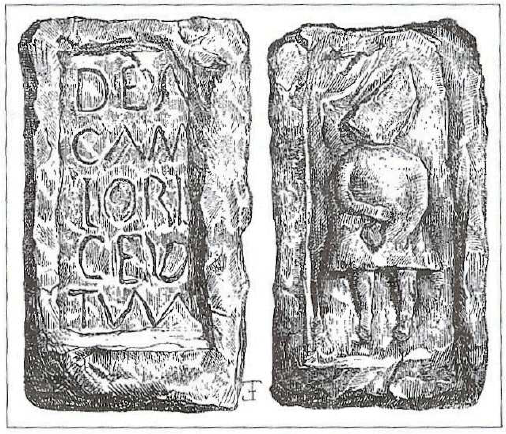d) Camuloriga (‘Queen of the Champions’)
The goddess name Camuloriga is mentioned in an inscription discovered around 1844 in Soissons (Aisne), in the territory of the Suessiones: Deae Camlorig(a)e votum, ‘To the Goddess Camuloriga a vow (was made)’ (fig. 38).1624 On the reverse of the stele*, the relief* of a standing character wearing a short tunic and holding a purse in his/her right hand appears. Since the drawing is rough and mutilated, it is difficult to determine the identity of the personage: is it a man or a woman? Could it be the representation of the goddess Camuloriga? Her name might again be distinguished on an altar from Ponts-les-Bonfays (Vosges), in the territory of the Leuci - a bust of a woman is engraved on the right panel and the bust of a man is portrayed on the left panel (fig. 39). The inscription could be either read Camu[l]oric[i or Camu[l]oric[ae.1625 As Espérandieu points out, this inscription is certainly a funerary altar bearing the name of the deceased rather than a votive stele* representing the divine couple Camulorici / Camuloriga.1626
On account of the similarity in names, Camuloriga might be related to the god Camulus, who is venerated in ten inscriptions from Britain, France, Belgium, Germany, Hungary and Italy, six of which equate him with Mars.1627
Camuloriga is composed of camulo, which means ‘champion’ or ‘servant’, and riga, ‘queen’.1628 Being a divine entity, Camuloriga is to be understood as ‘Queen of the Champions’ rather than ‘Queen of the Servants’. Her name is the feminine version of Camulorix (‘King of the Champions’), which is not attested as a divine name but occurs as a proper name in Ratcliffe-on-Soar (GB), Stackpole Elidur (GB) and Bourg-en-Bresse (Ain).1629 In view of the significance of her name, W. Fröhner identifies Camuloriga with the Roman goddess of war Bellona.1630 She may have been the one who presided over the hero-warriors in time of war, protecting, encouraging and leading them to victory. Besides, it can be noted that the Suessiones, who neighboured on the Remi, were one of the mightiest Belgian tribes of northern Gaul, and that their King, Diviciacos, is described as the most powerful chief of Gaul by Caesar in De Bello Gallico.1631 Therefore, it would not be surprising that this tribe venerated a divine war leader personifying their strength and success, commanding them and ensuring them triumph.

![Fig. 39: Mutilated altar from Pont-les-Bonfays (Vosges) dedicated to Camu[l]ori[ca] (?), with, on the right, the representation of the bust of a woman, and, on the left, the bust of a man. Musée d’Épinal (Vosges).](/documents/getpart.php?id=1266&file=10000000000002D200000151058CD5AD.png)